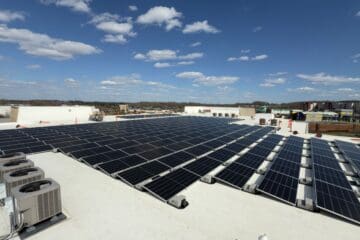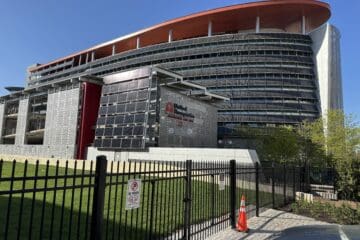Community solar is becoming a go-to solution in providing ratepayers access to cheaper, clean energy
Find out how
Why have only 3.5% of all commercial buildings in the United States installed rooftop solar? Certainly the economic and environmental case is clear, policy is very supportive in many states and the technology and financing strategies are tried and tested. While the reasons for any individual building may vary there has traditionally been one major issue for deploying solar at many commercial properties- the property owners don’t pay the electricity bills.
I’ll give you an example: think of your neighborhood shopping center. There may be several big box stores, a grocery store and several smaller restaurants and shops. Although these buildings are physically connected and often owned by one landlord, nine times out of ten each tenant has their own separate meter and pays their own separate electricity bill. As solar traditionally needs to connect to one utility account that gets all the benefit, even if the owner of the shopping center really wanted to go solar where would they connect? This is precisely the problem that has been solved by a new structure for solar deployment called community solar.
Community Solar allows that shopping center owner to build a sizable rooftop solar array and connect it directly to the grid. However, instead of just selling clean electricity to the electrical utility the unique innovation with community solar is that solar power can be sold directly to ratepayers in the same utility territory. This has a multitude of benefits:
- Allowing ratepayers who want to buy solar electricity to do so without having to install on their homes
- Providing a great revenue stream for the building owner
- Programs offering sizable discounts on electricity to LMI (low to moderate income) families.
The basic structure is shown in the diagram below. Rooftop owners can either own their community solar installation directly or contract with a financial investor to build and own the array and pay them a recurring lease payment for the use of their roof space. The owner of the project contracts with a commercial solar installer, like Aurora Energy, to build the array and receives all applicable solar incentives such as state & federal tax credits, Solar Renewable Energy Credits (SRECs) and electricity sales revenue.
Electricity sales revenue comes from individual subscribers who sign up to offtake (or utilize) the solar generated from a community solar project, usually at least a 5% discount to their prevailing electricity rate. These subscriptions are managed by a subscriber organization who contracts with the project owner to sign-up and manage community solar subscriptions and reconcile their bills with the utility to ensure they achieve savings.
Today 22 states and Washington DC have policies in place to support community solar and over 3GW of installations have been completed across the nation so far. Both Maryland and DC have robust community solar programs and as a result, have enjoyed strong deployment. Virginia should be showing up on the scene in the next several years thanks to recent favorable solar legislation. In these states, commercial property owners don’t have to pay sizable electricity bills anymore; and community members don’t have to install panels on their roofs anymore in order to reap the benefits of solar.
Community solar is an elegant structure that matches the desire of millions (who want to use renewable power for their homes and businesses) to the sought solution of commercial property owners in creating a beneficial outcome to their underutilized rooftop asset(s).
If you have interested in how to take advantage of this community solar deployment, please contact Aurora Energy to discuss at cord@aurora-energy.com
Photo credit: Markus Spiske



